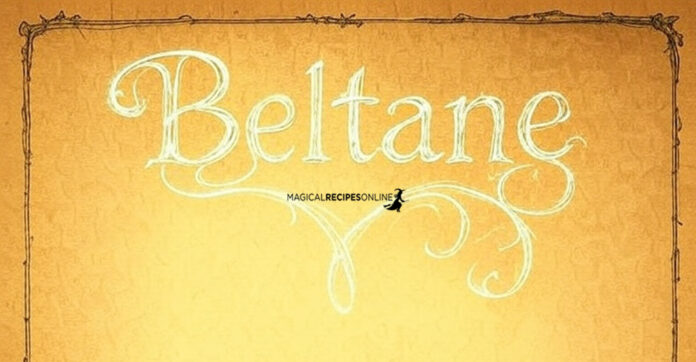Beltane, celebrated around May 1st, is a radiant Celtic festival marking the peak of spring’s vitality and the shift toward summer’s warmth. Rooted in ancient Gaelic traditions of Ireland, Scotland, and the Isle of Man, it weaves together themes of fertility, fire, and the mystical interplay between the human world and the Otherworld, where fairies, spirits, and deities dwell. Its name, possibly derived from the Gaelic Bealtaine meaning “bright fire,” evokes the festival’s core element: fire as a force of purification, transformation, and life. Beltane is a liminal time, when the veil between realms thins, much like at Samhain, allowing fairies—known as the Aos Sí or “people of the mounds”—to roam freely, their presence vivid and palpable, as you’ve noted with their heightened manifestation.
during Beltane Fairies are near!
The lore of Beltane fairies pulses with life and magic. Communities once lit towering bonfires to honor the sun’s growing strength, driving cattle between flames to protect them and leaping over embers to invite luck and fertility. These fires were more than practical; they were sacred, embodying the spark of creation and the cleansing power of light. Beltane also celebrates the sacred union of the Earth Goddess and Sun God, or later figures like the May Queen and Green Man, whose symbolic marriage ensures the land’s abundance—seen in blooming flowers, sprouting crops, and the mating of animals. This theme of fertility extended to human rituals, with handfasting ceremonies binding lovers for a year and a day, or sometimes for life, under the season’s potent energy.
Yet, the festival carries a dual nature: it’s both joyous and cautious. The thinning veil invites fairies, who dance in moonlit rings and guard sacred hawthorn trees, streams, and ancient mounds. These Aos Sí are powerful, capricious beings in Irish mythology, capable of blessing or cursing humans. Folklore brims with tales of people lured into fairy dances, only to lose years in the Otherworld, or receiving gifts of inspiration from kind encounters. To honor them, offerings of milk, honey, or bread were left at fairy mounds, while harming a hawthorn tree risked their wrath. Sacred sites like wells, hills, and stone circles were seen as portals, shimmering with Otherworldly energy during Beltane’s peak.
Beltane, celebrated around May 1st, is a Celtic festival associated with fertility, fire, and the height of spring, when the veil between worlds is believed to thin, making fairies more present. Here are five signs of heightened fairy presence during Beltane, based on folklore and traditions:
- Unexplained Sparkles or Lights: You might notice fleeting glimmers or twinkling lights in gardens, forests, or near water, especially at dawn or dusk. These are often attributed to fairy energy or their playful movement.
- Sudden Blooming or Vibrant Nature: Flowers, particularly hawthorn, may bloom unexpectedly or appear unusually vivid. Fairies are tied to nature’s vitality, and their presence can amplify the lushness of spring greenery.
- Mysterious Sounds or Music: Soft whispers, giggles, or faint music without a clear source may be heard, especially near fairy rings (circles of mushrooms) or ancient trees, signaling their gatherings.
- Offerings Disappearing: Food, milk, or small trinkets left out for fairies—common Beltane offerings—may vanish or be moved. This suggests fairies have accepted the gifts, a sign of their active presence.
- Feeling Watched or Tingly Sensations: A subtle sense of being observed or a tingling on your skin, particularly in natural settings, can indicate fairies nearby, drawn to the festive energy of Beltane.
- Fairy Rings Appearing: New or more prominent circles of mushrooms, grass, or flowers may form in fields or forests. These are considered fairy dance grounds, especially active during Beltane’s festive energy.
- Animals Acting Strangely: Pets or wild animals might seem alert, playful, or skittish for no apparent reason, as fairies are believed to interact with creatures, influencing their behavior during this time.
- Dreams of Otherworldly Beings: Vivid dreams featuring ethereal figures, nature spirits, or enchanted landscapes may occur, as fairies are thought to communicate through dreams when their presence peaks at Beltane.
- Objects Moving or Misplaced: Small items like keys, jewelry, or tools may inexplicably shift or go missing, only to reappear later. Fairies are known for playful mischief, especially during this spirited festival.
- Sudden Breezes or Chimes: Gentle, unexplainable gusts of wind or the sound of bells or chimes in still air may signal fairies passing by, drawn to Beltane’s vibrant, magical atmosphere.
These signs align with Celtic beliefs about fairies being more active during seasonal transitions like Beltane, when their influence is thought to peak. If you’re in a rural area or near traditional fairy sites (e.g., hawthorn trees or stone circles), these signs may be more pronounced. Moreover, these signs reflect the lore of fairies being more active and mischievous during Beltane, particularly in natural or sacred spaces. Keep an eye out near traditional fairy haunts like streams, hills, or oak groves.
how to avoid being rude with fairies
In Celtic folklore, particularly during Beltane fairies are especially active, avoiding rudeness with the Aos Sí (the fairy folk) is crucial to prevent their mischief or wrath. Fairies, or the “Good Folk,” are powerful, capricious beings who demand respect for their connection to nature and the Otherworld.
Respect begins with how you speak of fairies. Always refer to them as the “Good Folk,” “Fair Folk,” or “People of Peace,” even in casual conversation, as they are believed to listen and take offense at derogatory terms or mockery. During Beltane, when the veil between worlds is thin, your words carry extra weight, so maintain a tone of reverence, whether you’re near a hawthorn tree or simply discussing their lore. Avoid boasting about encountering them or claiming power over their realm, as fairies value humility and may retaliate with tricks, like misplacing your belongings or souring your luck.
When moving through nature, especially during Beltane’s vibrant nights, tread carefully to honor fairy spaces. Never step into a fairy ring—those circles of mushrooms, grass, or flowers—without permission, as these are their sacred dance grounds, and intruding can pull you into their world or invite their ire. If you come across one, walk around it respectfully, perhaps leaving a small token like a pebble or flower as a gesture of goodwill. Similarly, avoid disturbing fairy sites like hawthorn trees, ancient mounds, or streams, which are portals to their realm. Cutting down a hawthorn or digging near a fairy mound is a grave insult, believed to bring illness or misfortune. Instead, adorn these trees with ribbons or flowers during Beltane to show appreciation, tying your offering gently to avoid harm.
Offerings are a time-honored way to show courtesy. So, Beltane Fairies delight in gifts that reflect the earth’s bounty, so on Beltane eve, leave out a small bowl of milk, cream, or honey near a tree, stream, or garden edge. Freshly baked bread, a sprinkle of oats, or shiny trinkets like beads also please them, but ensure the offerings are natural and free of iron, which repels fairies and may offend them. Speak softly as you leave the gift, expressing gratitude for their presence and the beauty of the season, but don’t linger expecting thanks—fairies give blessings on their terms. Never consume their offerings yourself or treat them carelessly, as this is seen as theft and could provoke their anger.
Your actions in daily life also matter. Fairies are guardians of nature, so disrespecting the land—littering, polluting streams, or harming plants—can anger them, especially during Beltane’s celebration of fertility. Instead, tend to the earth with care, perhaps planting flowers or cleaning a natural space as an act of devotion. If you take something from their domain, like a stone or flower, ask permission aloud and leave something in return, such as a strand of hair or a kind word. This exchange acknowledges their stewardship and keeps the balance.
Finally, protect yourself without implying distrust. Carrying a small charm, a Brigid’s cross or a stone with a natural hole – holey, aligns with Beltane’s magic and wards off unwanted fairy attention without offending them. Wearing a piece of clothing inside-out during twilight walks confuses mischievous fairies, but it’s a neutral act that doesn’t challenge their power. If you sense their presence—perhaps a sudden breeze or a tingle on your skin—acknowledge it with a nod or a quiet “I mean no harm” rather than ignoring or confronting them.
How to ask for Fae Blessings
On April 30th or May 1st, visit a natural fairy site like a hawthorn tree, stream, or fairy ring at dawn or dusk. Bring a small offering—milk, honey, bread, or a flower—and place it gently near the site, avoiding iron. Speak softly, addressing the “Good Folk” with gratitude for their presence and the beauty of spring. Humbly request their blessing for a specific desire, like creativity, love, or prosperity, keeping your words simple and heartfelt. For example: “Fair Folk, I honor you this Beltane and offer this gift. Please bless me with inspiration in my work.” Don’t linger or demand a response; leave the offering and walk away respectfully. Tend to nature afterward, like planting flowers, to show ongoing reverence. This quiet, respectful act invites their favor without offense.

